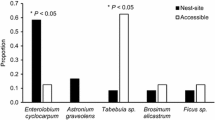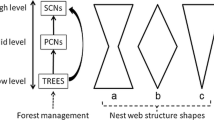Abstract
Invasive mammals include good tree climbers that use tree cavities for resting and nesting. Tree cavities are important but limited resources in most forests; thus, some invasive mammals can be serious competitors for native cavity-using species, especially cavity-nesting birds. Despite the potential impact, such inter-class competition has rarely been considered. We examined the possibility of resource competition for tree cavities between the invasive raccoon Procyon lotor and the native Ural owl Strix uralensis. Both species are nocturnal and use tree cavities during daytime. We assessed an overlap in cavity use for both species as an indication of potential competition by monitoring 341 cavities during their breeding season in a natural park in Hokkaido, Japan. Of 341 potentially available cavities, raccoons and Ural owls used 37 and 32, respectively. The characteristics of 58 cavities used by raccoons or owls were compared to 49 random cavities to determine if they selected cavities with certain characteristics. As predicted from a large amount of tree cavities and a low raccoon density in this managed forest, we did not find direct evidence of competition, such as physical interaction, intrusion to cavities, or habitat segregation. Cavity types used by both species overlapped considerably in terms of height, entrance size, depth, and other characteristics: their habitats were widely overlapped. Further, in four cavities, one species was replaced by the other. Given the similar habitat requirements, the invasive raccoon could be a potential competitor for Ural owl when raccoon density increases and/or cavity availability decreases, which is the case for many forests in Japan. This study suggests that potential threats of resource competition among not only closely but also distantly related taxa should be taken into consideration when studying the impacts of invasive species.





Similar content being viewed by others

References
Abe G, Ikeda T, Tatsuzawa S (2006) Differences in habitat use of the native raccoon dog (Nyctereutes procyonoides albus) and the invasive alien raccoon (Procyon lotor) in the Nopporo natural forest park, Hokkaido, Japan. In: Koike F, Clout MN, Kawamichi M, De Poorter M, Iwatsuki K (eds) Assessment and control of biological invasion risks. SHOUKADOH Book Sellers and Gland: The World Conservation Union (IUCN), Kyoto, pp 116–121
Asada M, Shinohara E (2009) Trial calculation of the population estimation for raccoon in 2009 in Chiba Prefecture, Japan. Res Pap Chiba Biodivers Cent 1:30–40
Bartoszewicz M, Okarma H, Zalewski A (2008) Ecology of the raccoon (Procyon lotor) from western Poland. Ann Zool Fennici 45:291–298. doi:10.5735/086.045.0409
Brazill-Boast J, Pryke SR, Griffith SC (2010) Nest-site utilisation and niche overlap in two sympatric, cavity-nesting finches. Emu 110:170–177. doi:10.1071/MU09045
Brown K, Innes J, Shorten R (1993) Evidence that possums prey on and scavenge birds’ eggs, birds and mammals. Notornis 40:169–177
Cockle KL, Martin K, Wesołowski T (2011) Woodpeckers, decay, and the future of cavity-nesting vertebrate communities worldwide. Front Ecol Environ 9:377–382. doi:10.1111/j.1744-7429.2010.00661.x
Davis D (2005) National tree climbing guide, 2005th edn. Missoula Technology and Development Center, Missoula
Fox J (2003) Effect displays in R for generalised linear models. J Stat Softw 8:1–27
Fox J, Andersen R (2006) Effect displays for multinomial and proportional-odds logit models. Sociol Methodol 36:225–255. doi:10.1111/j.1467-9531.2006.00180.x
García JT, García FJ, Alda F et al (2012) Recent invasion and status of the raccoon (Procyon lotor) in Spain. Biol Invasions 14:1305–1310. doi:10.1007/s10530-011-0157-x
Gibbons P, Lindenmayer DB (2002) Tree hollows and wild-life conservation in Australia. CSIRO Publishing, Sydney
Harrington LA, Harrington AL, Yamaguchi N, Thom MD, Ferreras P, Windham TR, Macdonald DW (2009) The impact of native competitors on an alien invasive: temporal niche shifts to avoid interspecific aggression. Ecology 90:1207–1216. doi:10.1890/08-0302.1
Hayama H, Kaneda M, Tabata M (2006) Rapid range expansion of the feral raccoon (Procyon lotor) in Kanagawa prefecture, Japan, and its impact on native organisms. In: Koike F, Clout MN, Kawamichi M, De Poorter M, Iwatsuki K (eds) Assessment and control of biological invasion risks. SHOUKADOH Book Sellers and Gland: The World Conservation Union (IUCN), Kyoto, pp 196–199
Hilton GM, Cuthbert RJ (2010) Review article: the catastrophic impact of invasive mammalian predators on birds of the UK Overseas Territories: a review and synthesis. Ibis 152:443–458. doi:10.1111/j.1474-919X.2010.01031.x
Hori S, Matoba Y (2001) Arthropods recognized from the contents in the digestive tract of raccoons. Bull Hist Mus Hokkaido 29:67–76 (in Japanese with English summary)
Ikeda T (1999) Progress of naturalization of raccoons and related problems in Hokkaido. The Annual Report on Cultural Sciences, Faculty of Letters, Hokkaido University 47:149–175 (in Japanese)
Ikeda T, Asano M, Matoba Y, Abe G (2004) Present status of invasive alien raccoon and its impact in Japan. Glob Environ Res 8:125–131
Ingold DJ (1998) The influence of starlings on flicker reproduction when both naturally excavated cavities and artificial nest boxes are available. Wilson Bull 110:218–225
ISSG (2012) Global invasive species database. http://www.issg.org/database/species/ecology.asp. Accessed 20 Sept 2013
IUCN (2012) The IUCN red list of threatened species. http://www.iucnredlist.org. Accessed 25 Aug 2012
Japan Forestry Agency (2010) Annual report on trends of forest and forestry: fiscal year 2009 (summary). Ministry of Agriculture, Forestry and Fisheries, Tokyo
Jennings DE, Krupa JJ, Raffel TR, Rohr JR (2010) Evidence for competition between carnivorous plants and spiders. Proc R Soc 277:3001–3008. doi:10.1098/rspb2010.0465
Kadosaki M (1996) Wildlife traces. Hokkaido Publishing & Planning Center, Hokkaido (in Japanese)
Kaneda M, Kato T (2011) A threat to amphibians and reptiles by invasive alien raccoons. Bull Herpetol Soc Jpn 2:148–154 (in Japanese)
Kappes JJ, Davis JM (2008) Evidence of positive indirect effects within a community of cavity-nesting vertebrates. Condor 110:441–449. doi:10.1525/cond2008.8472
Koch AJ, Martin K, Aitken KEH (2012) The relationship between introduced European starlings and the reproductive activities of mountain bluebirds and tree swallows in British Columbia, Canada. Ibis 154:590–600. doi:10.1111/j.1474-919X.2012.01242.x
Koenig WD (2003) European starlings and their effect on native cavity-nesting birds. Conserv Biol 17:1134–1140
Kontiainen P, Pietia¨inen H, Huttunen K, Karell P, Kolunen, Brommer JE (2009) Aggressive Ural owl mothers recruit more offspring. Behav Ecol 20:789–796. doi:10.1093/beheco/arp062
Kumschick S, Nentwig W (2010) Some alien birds have as severe an impact as the most effectual alien mammals in Europe. Biol Conserv 143:2757–2762. doi:10.1046/j.1523-1739.2003.02262.x
Lambrechts MM, Bourgault P, Mennerat A, Galan M-J, Catan-Son M, Perret P, Doutrelant C, Charmantier A (2007) Cavity-nesting black rats in distinct Corsican oak habitats and their potential impact on breeding Paridae. Folia Zool 56:445–448
Lõhmus A (2003) Do Ural owls (Strix uralensis) suffer from the lack of nest sites in managed forests? Biol Conserv 110:1–9. doi:10.1016/S0006-3207(02)00167-2
Lotze J, Anderson J (1979) Procyon lotor. Mammalian species. Am Soc Mammal 119:1–8
Martin K, Eadie JM (1999) Nest webs: a community-wide approach to the management and conservation of cavity-nesting forest birds. For Ecol Manage 115:243–257. doi:10.1016/S0378-1127(98)00403-4
Matsui S, Hisaka M, Takagi M (2010) Arboreal nesting and utilization of open-cup bird nests by introduced Ship Rats Rattus rattus on an oceanic island. Bird Conserv Int 20:34–42
Matsuoka S (2002) A device to inspect woodpecker cavities. Jpn J Ornithol 51:125–128 (in Japanese)
McComb WC, Noble RE (1981) Herpetofaunal use of natural tree cavities and nest boxes. Wildl Soc Bull 9:261–267
Mitchell J, Beck R (1992) Free-ranging domestic cat predation on native vertebrates in rural and urban Virginia. Va J Sci 43:197–207
Moll RJ, Millspaugh JJ, Beringer J, Sartwell J, He Z (2007) A new ‘view’ of ecology and conservation through animal-borne video systems. Trend Ecol Evol 22:660–668. doi:10.1016/j.tree.2007.09.007
Murakami O, Washitani I (2002) Handbook of alien species in Japan. Chijin-shokan, Tokyo, p 26 (in Japanese)
Newton I (1998) Population limitation in birds. Academic Press, London
Petraitis P (1979) Likelihood measures of niche breadth and overlap. Ecology 60:703–710
Poonswad P, Sukkasem C, Phataramata S et al (2005) Comparison of cavity modification and community involvement as strategies for hornbill conservation in Thailand. Biol Conserv 122:385–393. doi:10.1016/j.biocon.2004.08.002
Richardson CT, Miller CK (1997) Recommendations for protecting raptors from human disturbance: a review. Wildl Soc Bull 25:634–638
Robb JR, Cramer MS, Parker AR, Urbanek RP (1996) Use of tree cavities by fox squirrels and raccoons in Indiana. J Mammal 77:1017–1027
Sarà M, Milazzo A, Falletta W, Bellia E (2005) Exploitation competition between hole-nesters (Muscardinus avellanarius, Mammalia and Parus caeruleus, Aves) in Mediterranean woodlands. J Zool Lond 265:347–357. doi:10.1017/S095283690500645X
Shirer HW, Fitch HC (1970) Comparison from radiotracking of movements and denning habits of the raccoon, striped skunk and opossum in northeastern Kansas. J Mammal 51:491–503
Smith WP, Endres KM (2012) Raccoon use of den trees and plant associations in western mesophytic forests: tree attributes and availability or landscape heterogeneity? Nat Res 3:75–87. doi:10.4236/nr.2012.33012
Stokes VL, Banks PB, Pech RP, Spratt DM (2009) Competition in an invaded rodent community reveals black rats as a threat to native bush rats in littoral rainforest of south-eastern Australia. J Appl Ecol 46:1239–1247. doi:10.1111/j.1365-2664.2009.01735.x
Strubbe D, Matthysen E (2007) Invasive ring-necked parakeets Psittacula krameri in Belgium: habitat selection and impact on native birds. Ecography 30:578–588. doi:10.1111/j.2007.0906-7590.05096.x
Strubbe D, Matthysen E (2009) Experimental evidence for nest-site competition between invasive ring-necked parakeets (Psittacula krameri) and native nuthatches (Sitta europaea). Biol Conserv 142:1558–1594. doi:10.1016/j.biocon.2009.02.026
Stuewer FW (1943) Raccoons: their habits and management in Michigan. Ecol Monogr 13:203–257
Takenaka T (1999) Blakiston’s fish owl. In: Museum Shiretoko (ed) Library of Shiretoko, volume 1: aves in Shiretoko. Syari Town Board of Education, Hokkaido, pp 78–125 (in Japanese)
R Development Core Team (2010) R: a language and environment for statistical computing. http://www.r-project.org
Wiens JA (1989) The ecology of bird communities. Cambridge University Press, Cambridge
Wilson SE (2005) Demographic characteristics and habitat use of unexploited raccoons in southern Illinois. M.S. Thesis, Southern Illinois University, p 64
Wilson SE, Nielsen CK (2007) Habitat characteristics of raccoon daytime resting sites in southern Illinois. Am Midl Nat 157:175–186
Wilson PR, Karl BJ, Toft RJ et al (1998) The role of introduced predators and competitors in thedecline of Kaka (Nestpr meridionalis) populations in New Zealand. Biol Conserv 83:175–185. doi:10.1016/S0006-3207(97)00055-4
Yanagawa H, Muraki N (2005) Usability of tree cavities for wild mammals and case of conserving them. Symp Wildl Traffic 4:61–66 (in Japanese)
Acknowledgments
We appreciated valuable comments by Teru Yuta and two anonymous reviewers on the earlier version of the manuscript. We also thank Keiichi Fukaya for statistical analysis and Anna Sano, Kento Asahi, Michiko Fuziura, Shinji Moriya, and Satoshi Takagi for field assistance. This study was supported in part by a research Grant from Fujiwara Natural History Foundation.
Author information
Authors and Affiliations
Corresponding author
Appendix
Rights and permissions
About this article
Cite this article
Kobayashi, F., Toyama, M. & Koizumi, I. Potential resource competition between an invasive mammal and native birds: overlap in tree cavity preferences of feral raccoons and Ural owls. Biol Invasions 16, 1453–1464 (2014). https://doi.org/10.1007/s10530-013-0583-z
Received:
Accepted:
Published:
Issue Date:
DOI: https://doi.org/10.1007/s10530-013-0583-z



